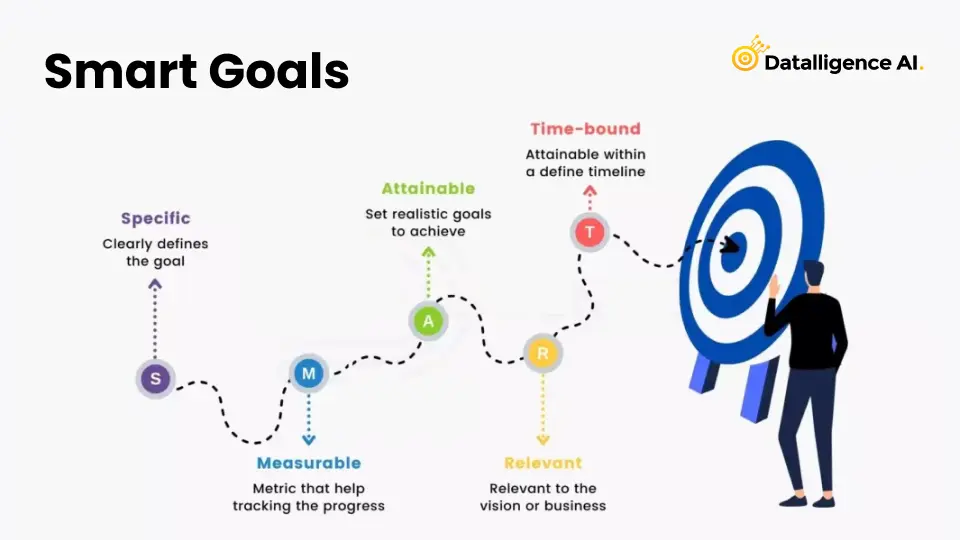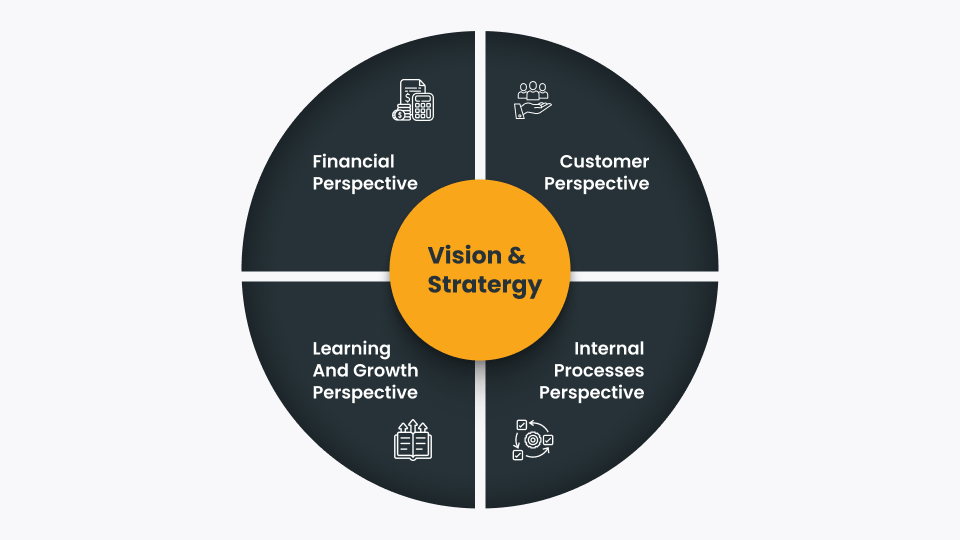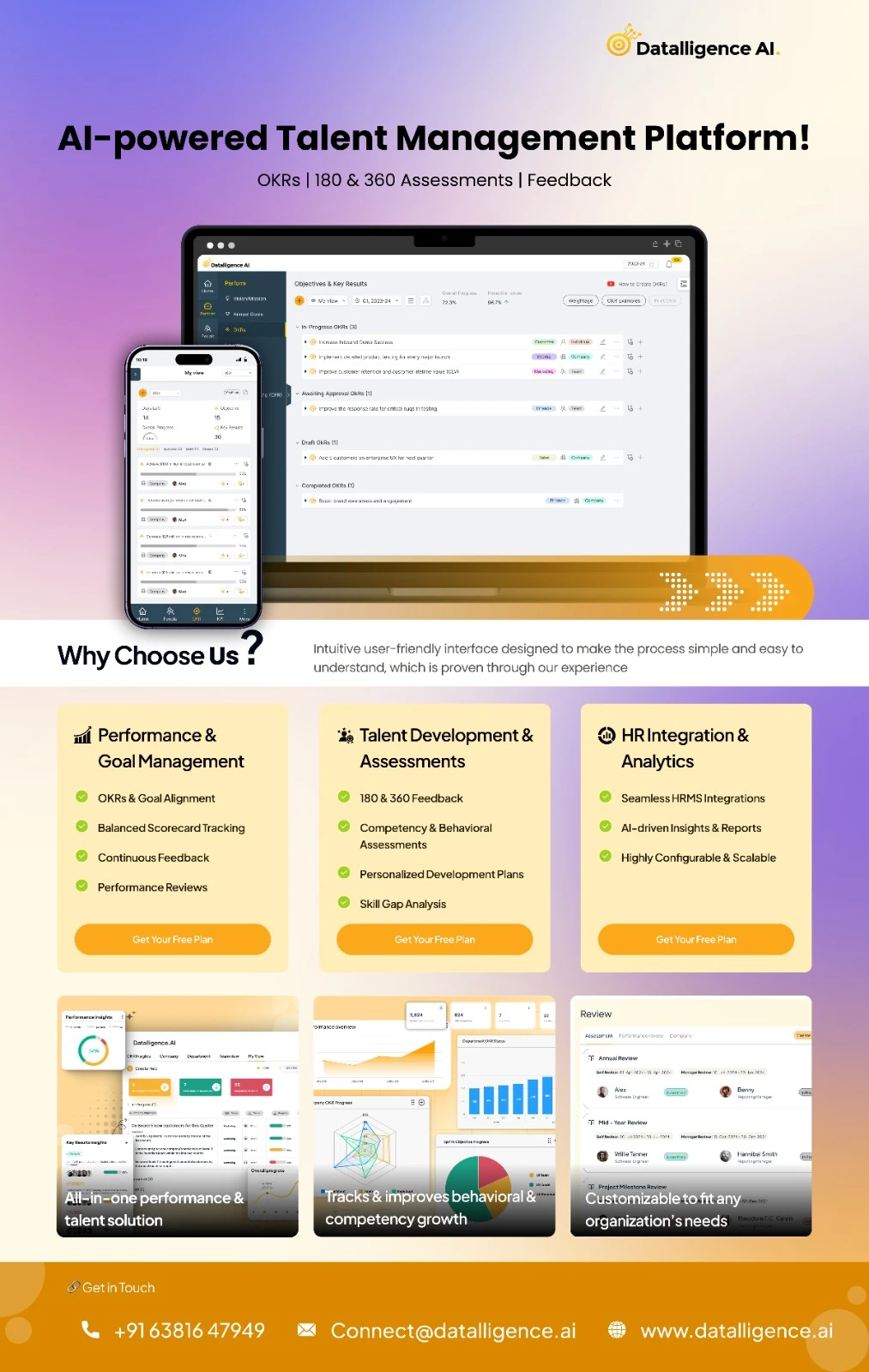What’s a Goal-Setting Framework?
Did you know that 91% of businesses with clear goals outperform their competitors? In today’s remote-first world, where teams are spread across time zones, the art of goal-setting is more important than ever. With employees working from anywhere, defining clear objectives isn’t just beneficial—it’s urgent. A robust goal-setting framework like OKRs can help align your long-term and short-term ambitions while keeping progress in check.
As the saying goes: “Those who fail to plan, plan to fail.” Setting actionable goals is your first step toward success.
Think of a goal-setting framework as your strategy blueprint. It’s a structured way to define, organize, and track goals. It connects your big-picture vision with actionable steps, ensuring every effort counts.
Here’s how it works:
- Define clear and specific goals.
- Break them into actionable steps.
- Regularly track progress and adapt.
Why Use a Goal setting Framework?
Using a goal-setting framework isn’t just about achieving more—it’s about working smarter. It helps you:
- Focus on clear objectives.
- Drive accountability across teams.
- Plan and allocate resources effectively.
- Track progress and measure results.
- Align strategy and decisions with your goals
Before You Dive Into Goal-Setting, Do This
Conduct a SWOT Analysis
Analyze your business’s Strengths, Weaknesses, Opportunities, and Threats. This gives you a 360-degree view of your internal capabilities and external challenges, providing a strong foundation for setting impactful goals. Where do you excel? What needs improvement? What opportunities can you seize, and what risks should you watch out for?

Use Benchmarking
Compare your business to industry standards or top competitors. Benchmarking helps you identify gaps and pinpoint where to improve. Learn from the best practices of others to set realistic, growth-driven goals.
Review Last Year’s Goals
Take a look back. What worked, and what didn’t? Understanding the factors behind last year’s wins or misses can refine your approach. Learn from the past to pave a clearer path forward.
OKRs (Objectives and Key Results)
OKRs, or Objectives and Key Results, are a popular goal-setting framework used by organizations to align their teams and drive measurable results. The method was popularized by companies like Google and Intel and has since become a widely adopted strategy for setting and achieving ambitious goals. OKRs consist of two primary components:
Objectives: These are the broad, qualitative goals you want to achieve. Objectives should be inspirational, clear, and ambitious—aiming to push the team to achieve more than they might think is possible. They should describe what you want to accomplish but not how you’re going to get there.
Key Results: These are the measurable outcomes that indicate whether you’ve achieved your objectives. Key results should be specific, quantifiable, and time-bound. They break down the objectives into actionable steps that can be tracked for progress. Each objective typically has around 2-5 key results.
How OKRs Work:
OKRs management tools work by linking individual and team goals to company-wide objectives, ensuring everyone is focused on the same outcomes. Each department or team defines its own OKRs that align with the broader organizational goals. This top-down and bottom-up approach ensures that the entire organization is working cohesively toward the same vision.
A typical OKR cycle lasts for a quarter or a year, but they can be reviewed and updated regularly, allowing teams to adjust goals as priorities shift. This flexibility is a key benefit, helping teams stay agile and aligned in a fast-paced business environment.
Why OKRs Matter:
OKRs drive performance and results by fostering clarity, transparency, and accountability. With clear objectives and measurable key results, employees know what’s expected of them and how their work impacts the larger company mission. Moreover, OKRs encourage a growth mindset, pushing teams to aim higher and improve continuously.
Example of OKRs:
For a marketing team, an example of an OKR could look like this:
- Objective: Increase brand awareness and online presence.
- Key Result 1: Grow website traffic by 30% by the end of the quarter.
- Key Result 2: Achieve 500 social media mentions per month.
- Key Result 3: Generate 50 qualified leads from content marketing efforts.
The strength of OKRs lies in their simplicity and focus, enabling teams to set ambitious goals while providing a clear structure for measuring progress and success.
S.M.A.R.T Goals
James Cunningham, Arthur Miller, and George Doran first presented this framework for setting goals in 1981. Goals that are specific, measurable, achievable, realistic and time-bound are described by the acronym SMART.
This strategy aids you in maintaining your attention on selecting goals that will result in better business outcomes.
Let’s delve deeper into this method of setting goals.
Specific: The goal should be clear and well-defined, leaving no room for ambiguity. It should answer the questions of who, what, where, when, and why.
Measurable: Should have a quantifiable aspect that allows you to track progress and determine success. This could be a numerical value, a percentage, or any other measurable indicator.

Achievable: Goal should be challenging yet realistic and attainable based on the resources, skills, and constraints you have. It should stretch your capabilities without being impossible to achieve.
Relevant: Set it relevant and aligned with your current priorities and objectives. It should have a direct impact on your work or desired outcomes.
Time-bound: Provide a specific timeframe or deadline for completion. This creates a sense of urgency and helps you stay focused. It’s important to set a realistic timeline that provides enough time to accomplish the goal.
How SMART Goals can be extended to SMARTER goals
Evaluate: Regularly assess your goals to gauge progress and make necessary adjustments. For instance, monitor your social media campaigns biweekly to ensure you are on track to reach the target of 15K followers.
Read just: Be adaptable and willing to modify your plans if needed. If your social media campaigns are not yielding the expected results, be prepared to readjust your strategy to stay aligned with your goal.
BHAG- Big Hairy, Audacious goal
A BHAG, which stands for Big Hairy Audacious Goal, is a powerful concept introduced by Jim Collins and Jerry Porras in their book “Built to Last.” A BHAG is an ambitious, long-term goal that stretches the imagination, challenges conventional thinking, and inspires organizations to achieve greatness.
A BHAG is not just an ordinary goal; it is bold, daring, and often seems almost impossible to achieve at first glance. It goes beyond incremental improvements and pushes individuals and teams to think big and aim for extraordinary outcomes. A BHAG serves as a unifying force, rallying people around a common purpose and inspiring them to go above and beyond their perceived limitations.
Here are a few examples of well-known BHAGs:
NASA’s BHAG: “Put a man on the moon and return him safely by the end of the decade.” This audacious goal, set by President John F. Kennedy, inspired the Apollo program and led to the historic moon landing in 1969.
Tesla’s BHAG: “Accelerate the world’s transition to sustainable energy.” This audacious goal drives Tesla’s mission to revolutionize the automotive industry and transform the way we generate and consume energy
Backward Goals
Backward goals, also known as reverse engineering goals, involve starting with a desired outcome or endpoint and then working backward to determine the necessary steps and milestones to achieve that outcome. Rather than focusing on the incremental progress from the present to the future, backward goals flip the traditional goal-setting approach by beginning with the end in mind.
Example for Backward Goal:
Launching a new product:
- Desired outcome: Successfully launch a new product and generate 10,000 sales within the first three months.
Backward goals:
- Milestone: Achieve 10,000 sales within three months.
- Steps: Execute marketing campaigns, establish distribution channels, conduct market research, finalize product design, develop a prototype, gather customer feedback, secure manufacturing partnerships, and conduct product testing.
Businesses that are unsure of their goals can benefit from using this goal-setting process.
They merely have an idealized vision of what their future should entail. They can convert that vision into quantifiable goals with the use of the backward goal
Balance Score Card
The Balanced Scorecard is a strategic performance management framework developed by Robert Kaplan and David Norton. It provides a comprehensive and balanced view of an organization’s performance by considering multiple dimensions beyond just financial indicators. The Balanced Scorecard incorporates a set of performance metrics across four key perspectives: financial, customer, internal processes, and learning and growth.

The four perspectives of the Balanced Scorecard are as follows:
Financial Perspective:
This perspective focuses on financial outcomes and measures the organization’s financial performance, such as revenue, profitability, and return on investment. It considers the financial health and sustainability of the organization.
Customer Perspective:
This perspective emphasizes meeting customer needs and expectations. It examines measures related to customer satisfaction, loyalty, retention, and market share.
Internal Processes Perspective:
This perspective looks at the internal operational processes that are critical to delivering value to customers and achieving financial objectives. It assesses process efficiency, quality, innovation, and other key performance indicators that drive operational excellence.
Learning and Growth Perspective:
This perspective focuses on the organization’s ability to learn, innovate, and develop capabilities for long-term success. It considers employee skills, training and development, knowledge management, and the fostering of a culture that encourages learning and improvement.
By using the Balanced Scorecard, organizations can balance their focus across these four perspectives to drive performance and strategic alignment.
One Word Goal Setting
One Word Goal Setting is a simplified approach to goal setting where you choose a single word that represents your focus or intention for the year ahead. Instead of creating a long list of resolutions or specific goals, you select one word that embodies your overall vision or desired state.
The concept behind One Word Goal Setting is to provide a clear and concise guide for your actions, decisions, and priorities throughout the year.
Examples of One Word Goal Setting:
“Balance”: Focusing on achieving a harmonious and well-rounded life by prioritizing self-care, work-life balance, and maintaining healthy relationships.
“Growth”: Prioritizing personal and professional development, seeking new opportunities, and expanding knowledge and skills.
“Focus”: Concentrating on deep work, eliminating distractions, and improving productivity by channeling attention and energy into specific goals.
Remember, the beauty of One Word Goal Setting is its simplicity. The chosen word should resonate with your aspirations and serve as a compass to guide your actions and choices throughout the designated period.
Locke and Latham’s 5 principles
Locke and Latham’s goal-setting theory proposes five principles that can enhance the effectiveness of goal-setting. These principles provide guidance on how to set goals that motivate individuals and lead to improved performance.
Here are the five principles:
Clarity: Clearly define and articulate specific, measurable, and challenging goals.
Challenge: Set goals that are ambitious but attainable, pushing individuals to strive for higher performance.
Commitment: Encourage individuals to be personally committed and invested in achieving their goals.
Feedback: Provide regular feedback and progress updates to help individuals track their performance and make necessary adjustments.
Task Complexity: Consider the complexity of the task and adjust goal difficulty accordingly to ensure optimal motivation and performance.
OGSM
OGSM is a goal-setting framework used in business and strategic planning. It stands for Objectives, Goals, Strategies, and Measures. Here’s a breakdown of each component:
Objectives: Objectives are high-level statements that outline the overall purpose or direction of an organization or project.
Goals: Goals are specific, measurable targets that support the objectives. They are more actionable and tangible than objectives, providing clear milestones or benchmarks to strive for. Goals should be aligned with the broader objectives and contribute to their fulfillment.
Strategies: Strategies are the broad approaches or plans that outline how the organization or project will achieve its goals. They define the key actions, initiatives, or methods that will be employed to reach the desired outcomes.
Measures: Measures, also known as metrics or key performance indicators (KPIs), are quantifiable indicators used to track progress and evaluate success.
The OGSM framework helps organizations establish a clear and structured approach to goal setting and strategic planning.
Goal Pyramid

The Goal Pyramid, also known as the Goal Setting Pyramid or the Hierarchy of Goals, is a visual representation of how goals can be organized and prioritized. It is a hierarchical structure that illustrates the relationship between different levels of goals, from broad and long-term aspirations to specific and short-term objectives. The pyramid is often used as a framework to guide individuals or organizations in setting and achieving their goals effectively.
Here’s a breakdown of the components of the Goal Pyramid, from bottom to top:
Foundation/Base: The foundation of the pyramid represents the ultimate purpose, vision, or mission statement.
Strategic Goals: The next level consists of strategic goals that support the foundation. Strategic goals often cover a medium-term timeframe, such as three to five years.
Tactical Goals: They represent concrete objectives that need to be accomplished to support the achievement of strategic goals.
Operational Goals: At the top of the pyramid are operational goals, which are highly specific and time-bound objectives.
HARD goals
HARD goal is an acronym that stands for Heartfelt, Animated, Required, and Difficult goals. This concept was introduced by author and motivational speaker Mark Murphy in his book “Hard Goals: The Secret to Getting from Where You Are to Where You Want to Be.”
The idea behind HARD goals is to set goals that are meaningful and challenging, pushing individuals to stretch their capabilities and achieve significant results.
Heartfelt: Goals that deeply matter to you and align with your values.
Animated: Goals that create a vivid mental picture of success to keep you motivated.
Required: Goals that are crucial and non-negotiable for achieving desired outcomes.
Difficult: Goals that challenge you and require significant effort for personal growth and achievement.
Goal Setting Methods: Tips For Setting Goals
Be Specific
Clearly define your goals with specific details and measurable outcomes. Avoid vague or ambiguous statements to ensure clarity and focus.
Set Challenging, yet Attainable Goals
Aim for goals that stretch your capabilities and drive growth, but make sure they are realistic and achievable within the given resources and timeframe.
Align with the Big Picture
Ensure that your goals align with the overall vision, mission, and strategic priorities of the business. This connection helps create a sense of purpose and direction.
Break Down into Milestones
Divide larger goals into smaller, manageable milestones or objectives. This makes progress more tangible, keeps motivation high, and allows for incremental achievements.
Make Goals Time-Bound
Set deadlines or target dates for accomplishing goals. This adds a sense of urgency and helps with prioritization and effective time management.
Conclusion
In conclusion, a goal-setting framework provides a structured approach to setting and achieving goals effectively. By using a framework, such as the OKR methodology. To make goal setting a success, it is important to be specific, align goals with the bigger picture, break them down into manageable milestones, set deadlines, and regularly track progress while adapting as needed., businesses can align their objectives, set measurable targets, and track progress to drive success.
Datalligence, A leading OKR software platform, can greatly assist in implementing and managing goal-setting frameworks. It offers a comprehensive suite of tools and features to streamline the goal-setting process, track key results, foster transparency and collaboration, and provide real-time insights into progress.











